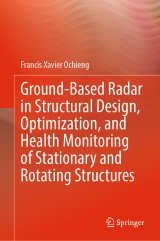Details

Ground-Based Radar in Structural Design, Optimization, and Health Monitoring of Stationary and Rotating Structures
|
128,39 € |
|
| Verlag: | Springer |
| Format: | |
| Veröffentl.: | 10.06.2023 |
| ISBN/EAN: | 9783031290084 |
| Sprache: | englisch |
Dieses eBook enthält ein Wasserzeichen.
Beschreibungen
<p>This book provides a practical application for using ground-based radar (GBR) as a remote (non-contact) sensor for structural health monitoring (SHM) in the development of sustainable and robust stationary and rotating structures, such as beam-like bridges, towers, wind turbines, and hydropower turbines. It integrates cutting-edge research into an easy-to-understand approach for non-radar and monitoring specialists, building on the methods and theory of working with radar systems, SHM frameworks, GBR signal processing, and validation techniques. All aspects of in-field monitoring and use during the design and testing of structures are covered, including data acquisition and processing, damage detection techniques, and damage prognostic techniques. The book is a hands-on reference that provides critical information on GBR for practitioners, university instructors, and students involved in structural design, optimization, and health monitoring of stationary and rotating structures. </p><div><br></div>
<div>Sensors for structural health monitoring.- Ground-based radar (GBR) overview.- The working theory of GBR.- Signal processing of GBR data.- Deflection and modal analysis of GBR data.- Methodology in GBR field applications.- Case study: Application of GBR for non-rotary systems.- Case study: Application of GBR for onshore operating wind turbines.- The future of GBR.- Appendix A: GBR Matlab codes.- Appendix B: Answers to chapter specific questions.- Appendix C : OMA diagrams.</div><div><br></div>
<div><p>Francis Xavier Ochieng, Ph.D., has in-depth experience working in the energy sector with a specific emphasis on structural health monitoring of wind and hydropower systems, including their structural damage detection, and further experience in using ground-based radar in the monitoring of wind turbine systems. His research interests are in energy systems, non-contact structural health monitoring of energy systems, energy analytics and econometrics, green jobs, and energy policies. Dr. Ochieng earned his Ph.D. in Energy Technologies from the University of Nottingham, UK, and his MSc in Renewable Energy from the University of Oldenburg, Germany.<br></p></div>
<p>This book provides a practical application for using ground-based radar (GBR) as a remote (non-contact) sensor for structural health monitoring (SHM) in the development of sustainable and robust stationary and rotating structures, such as beam-like bridges, towers, wind turbines, and hydropower turbines. It integrates cutting-edge research into an easy-to-understand approach for non-radar and monitoring specialists, building on the methods and theory of working with radar systems, SHM frameworks, GBR signal processing, and validation techniques. All aspects of in-field monitoring and use during the design and testing of structures are covered, including data acquisition and processing, damage detection techniques, and damage prognostic techniques. The book is a hands-on reference that provides critical information on GBR for practitioners, university instructors, and students involved in structural design, optimization, and health monitoring of stationary and rotating structures. </p><div><ul><li>The first book dedicated to ground-based radar for structural health monitoring; </li><li>Provides worked-out exercises, comprehensive case studies, and numerous examples; </li><li>Establishes the use of a 3-tier SHM framework in the context of non-contact sensors.</li></ul></div>
The first book dedicated to ground-based radar for structural health monitoring Provides worked-out exercises, comprehensive case studies, and numerous examples Establishes the use of a 3-tier SHM framework in the context of non-contact sensors
Diese Produkte könnten Sie auch interessieren:

Water Quality Hazards and Dispersion of Pollutants

von: Wlodzimierz Czernuszenko, Pawel Rowinski

149,79 €















